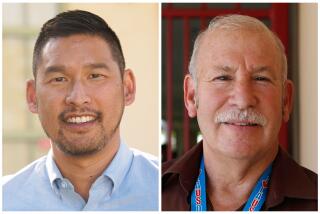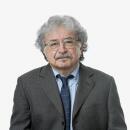Compromise Elusive in L.A. Schools Crisis
- Share via
As the Los Angeles Unified School District lurches through its latest crisis, a host of would-be saviors have emerged to try to fashion a compromise that would salvage Supt. Ruben Zacarias’ dignity while letting the school board take more control of its operations.
Among those attempting to find a painless end to the standoff, even as a push grows to break up the school district, are Assembly Speaker Antonio Villaraigosa, school board member David Tokofsky, city school bond oversight Chairman Steve Soboroff, Los Angeles County Supervisor Zev Yaroslavsky and former Councilman Richard Alatorre.
So far, none has come up with the magic solution, but it’s not for lack of trying. A potential showdown looms Thursday, with the board scheduled to take public comment on the appointment of former real estate attorney Howard Miller to a position overseeing all district departments and divisions.
The initial action in closed-door session two weeks ago was widely seen as an end-run around Zacarias. It sparked protests about due process, leading to the agreement by the board to hold a new meeting.
But four board members have vowed to again place Miller in direct charge of day-to-day operations, despite protests from Latino elected officials and civil rights leaders. And Zacarias has steadfastly refused to give up direct authority over the chain of command.
“If there’s no compromise, we’re going to court,” said Zacarias’ attorney, Joseph Coyne, a corporate litigation specialist. “Ruben has to retain his authority, but the board is intransigent. We’re optimistic the board’s action would not stand up in court.”
Villaraigosa, whose background is in union organizing, met separately last week with school board President Genethia Hayes and Zacarias, and then acted as an intermediary for several days, emerging with what he said was the outline of a deal.
Under Villaraigosa’s proposal, Zacarias would be restored to full control over the district at least until the board evaluates him and holds a public hearing.
Until then, Miller would have the title of chief operating officer, with more limited authority.
As of Sunday afternoon, Villaraigosa said his shuttle diplomacy was close to paying off. He said Hayes had agreed to the proposal and that Zacarias was close to accepting it as well. Hayes could not be reached for comment.
“They have to redo the process,” he said Sunday, of the board. “Ruben would have to be reinstated as CEO. You can’t neuter him. You can review him and get rid of him, but you can’t do the other.”
At the same time, “you can’t say that the school board can’t fire a Latino superintendent,” he said. “Accountability has to be colorblind.”
Others close to the talks, however, said Monday that Villaraigosa’s proposal was not likely to break the deadlock.
School board members had agreed last week to change Miller’s title, but Zacarias rejected that as a compromise. This week, he plans to announce his own plan for restructuring the district management.
Board members Hayes, Caprice Young, Mike Lansing and Valerie Fields have said they have no intention of diminishing Miller’s authority.
For Villaraigosa, the chance to broker a compromise is an appealing one that would affirm his place at the center of divisive, ethnic political struggles and unquestionably boost his broad appeal as he launches his campaign for mayor.
Similarly, two other wannabe brokers have distinct political incentives to emerge as the peacemaker in the current debate.
Soboroff is an announced candidate for mayor, and Yaroslavsky is a potential candidate. Each starts with supporters in the San Fernando Valley and the Westside, but each needs Latino support to win, so orchestrating a truce in the ethnically charged debate would serve their interests well.
“I’ve offered to help everybody who is in the middle of this [as a mediator],” Yaroslavsky said. “I called Richard Alatorre. . . . I’ve talked to several school board members. I’ve put in a call to Zacarias. I’m willing to play any role I can.”
Tokofsky has suggested a mediator, preferably Latino, to sit down with Zacarias and Hayes and resolve their differences. Alatorre could not be reached for comment.
Amid the increasingly fractious debate surrounding the stalemate between Zacarias and the board, the notion of breaking up the district has been gaining momentum. Potential scenarios under discussion range from splitting the district in half to blasting it into dozens of mini-districts.
Among those now entertaining the idea is Fernando Guerra, director of the Center for the Study of Los Angeles at Loyola Marymount University, who until recently was a strong supporter of the board members elected earlier this year.
“In their haste to reform the district,” he said, “the new board members only repeated the same mistake of the previous board by doing things behind closed doors and feeling they are not accountable.
“Now, I’m of the opinion that if the district were broken up into as many as 35 mini-districts of 35,000 to 50,000 students, it would allow communities to truly monitor and hold each of those districts accountable,” said Guerra, who has been an informal advisor to Mayor Richard Riordan on education issues.
Disappointment with the board has prompted Alan Clayton, research chairman of the Los Angeles City/County Latino Redistricting Coalition, to explore the possibility of a new Eastside district, which would have a Latino majority both in the classroom and the voting booth.
Yaroslavsky said. “I called Richard Alatorre. . . . I’ve talked to several school board members. I’ve put in a call to Zacarias. I’m willing to play any role I can.”
Soboroff, an advisor to Riordan, also is said to be considering ,public discussions about the ramifications of breaking up the nation’s second-largest school district. Soboroff, however, on Monday denied that he was exploring a possible breakup of the district.
But Virgil Roberts, a prominent Los Angeles attorney and school reformer, cautioned that “people need to be careful not to overreact. Breakup sounds like a magic bullet. It’s not.”
“It’s hard to believe we would be better off with 30 districts, 15 of which would probably be like Compton’s,” he said, referring to the troubled Compton Unified School District. That district was taken over by the state in 1993 because of academic and financial problems.
Added Roberts: “It’s sad that the conversations about breaking up the district center on power for adults. No one is talking about improving education for kids.”
More to Read
Sign up for Essential California
The most important California stories and recommendations in your inbox every morning.
You may occasionally receive promotional content from the Los Angeles Times.















